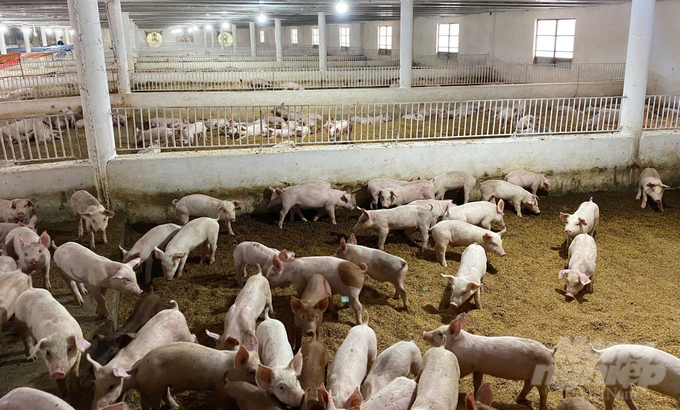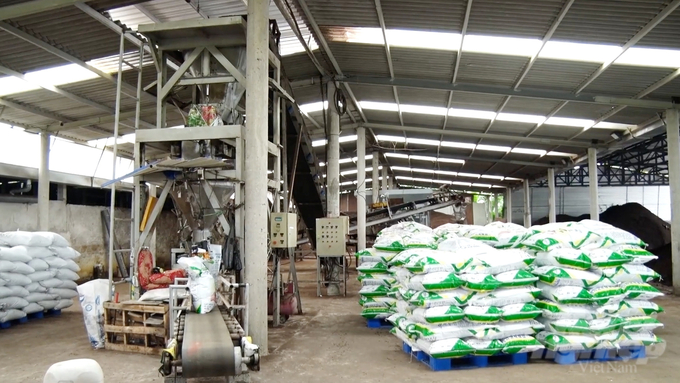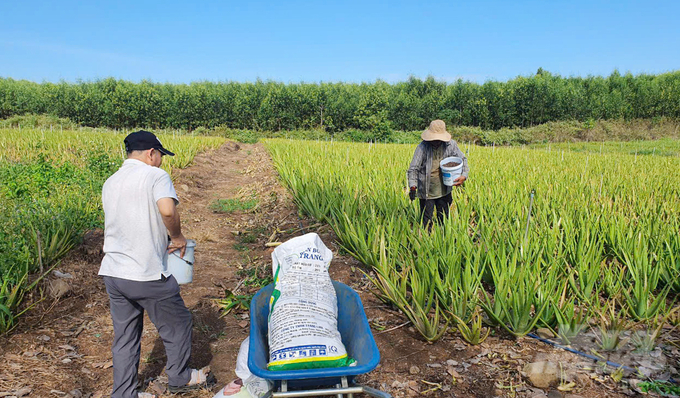December 6, 2025 | 04:39 GMT +7
December 6, 2025 | 04:39 GMT +7
Hotline: 0913.378.918
December 6, 2025 | 04:39 GMT +7
Hotline: 0913.378.918

Trang Linh Company's pig farming model on biological bedding helps reduce costs and limit environmental pollution. Photo: Le Binh.
However, the cost of pig farming is particularly prone to numerous factors amid the escalating complexity of disease outbreaks. For numerous producers and businesses, these are the reasons that have resulted in their struggles and obstacles in maintaining their professions. Pig producers are required to reduce production costs and increase value in order to generate a profit. The solution is to "transform wastes into profit."
One of the few enterprises that has successfully converted livestock waste into a primary product is Trang Linh Co., Ltd., located in Xuyen Moc District, Ba Ria - Vung Tau Province. Trang Linh Company has converted biological bedding into organic fertilizer for agriculture.
In response to disease challenges, Trang Linh Company has transitioned between a variety of farming methodologies many times since its establishment in 2002. Pham Truong Giang, Director of Trang Linh Co., Ltd., disclosed that their farms had previously employed biogas systems to manage pig refuse and wastewater. Nevertheless, this approach demonstrated numerous drawbacks and was not the most effective for production.
"We initiated research on the use of biological bedding for pigs in 2012 and formally enacted it in 2017. It has substantially diminished the costs of cultivation, environmental pollution, and disease outbreaks. All labor, utilities, medication, and antibiotics for pigs have been reduced," Giang stated.

Trang Linh Company's factory producing organic fertilizer from biological bedding, with a capacity of 600 tons. Photo: Le Binh.
The farm produces approximately 1,200 tons of waste and byproducts each month, with a herd size of approximately 4,000 pigs per litter. Trang Linh Company yields approximately 600 tons of fertilizer per month for crop cultivation following high-temperature decomposition to generate microbial organic fertilizer.
During the initial phases, Trang Linh Company fertilized over 30 hectares of forest internally using organic fertilizer from biological bedding, which was necessary due to the substantial volume of waste and byproducts produced annually. Giang began marketing the fertilizer locally, where it was well-received, after recognizing its exceptional quality.

Trang Linh Company's organic fertilizer products are sold to cooperatives and organic farming enterprises in and outside Ba Ria - Vung Tau province. Photo: Le Binh.
"We distribute approximately 500 tons of organic fertilizer to cooperatives located both within and outside the province monthly. Durian cultivation in the Central Highlands is the primary application of Trang Linh's organic fertilizer," Giang further stated.
The profit margin for fertilizer production from biological bedding is 60-70%, as per the Director of Trang Linh Co., Ltd. Giang disclosed that the profits generated from fertilizer production alone are adequate to support the company's labor expenses. This enables the organization to generate profits from other investment sectors without being unduly pressured by market fluctuations or competition.
Additionally, Trang Linh Co., Ltd. is the initial organization in Ba Ria - Vung Tau Province to attain the designation of a High-Tech Agricultural Enterprise. The Department of Livestock Production recently recognized the company as an exemplary enterprise in the field of livestock refuse management and treatment technology.
Nguyen Xuan Trung, the Head of the Sub- Department of Livestock Production and Animal Health in Ba Ria - Vung Tau Province, commended Trang Linh for its closed, circular model, which is extremely profitable and leads the way. Addressing the critical issue of environmental pollution - a challenge that all localities face - Trang Linh has demonstrated how to transform "waste into money."
Nguyen Xuan Trung also commented: "This is a model project for organizing domestic and international study excursions to learn from and replicate amidst the many challenges we face."
At present, Trang Linh provides technical assistance to local farmers regarding livestock husbandry using biological bedding following the resolution of the Provincial People's Council of Ba Ria - Vung Tau. The company is committed to purchasing bedding from producers who adhere to the correct techniques and maintain consistent production. This initiative enhances the income of local pig producers and guarantees more reliable production.
Trang Linh Co., Ltd (Trang Hoang Hamlet, Bong Trang Commune, Xuyen Moc District) is the first unit in Ba Ria - Vung Tau province to be recognized as a high-tech agricultural enterprise. The company's main field of operation is pig breeding with an area of over 70 ha, more than 200 employees, raising animals using high technology. Trang Linh also produces organic fertilizers, grows clean vegetables in nethouses and raises freshwater fish on its own farm.
Translated by Linh Linh

(VAN) As of 2025, the ASEAN region has a total of 69 ASEAN Heritage Parks recognized across its 10 member states. Among them, Viet Nam contributes 15 ASEAN Heritage Parks.

(VAN) Yok Don National Park has high biodiversity with numerous endemic plant and animal species, and it is also the only dipterocarp forest ecosystem conservation area in Viet Nam.

(VAN) Viet Nam and Brunei signed two important MOUs on fisheries and IUU, expanding cooperation in agriculture, the environment, and Halal exports, aiming to substantively implement joint projects.

(VAN) The Viet Nam Coconut Association worked with the International Finance Corporation (IFC) and businesses to promote the supply chain, enhance competitiveness, and develop the coconut industry sustainably.
![Hue aims for Net Zero: [2] Pioneering low-emission tourism](https://t.ex-cdn.com/nongnghiepmoitruong.vn/608w/files/huytd/2025/12/04/0633-dulichzero-4-095634_236-161125.jpg)
(VAN) The ancient capital of Hue has developed Net Zero tourism products and models, aiming to reduce carbon emissions and pioneer the establishment of Viet Nam's green tourism destination.

(VAN) C.P. Viet Nam has announced the successful completion of its goal to plant 1.5 million trees during the 2021-2025 period, a key milestone within company's long-term ESG strategy and its roadmap for emission reduction.

(VAN) This is an initiative of MAE aimed at creating a unified coordination mechanism to implement agricultural cooperation programs with developing countries.